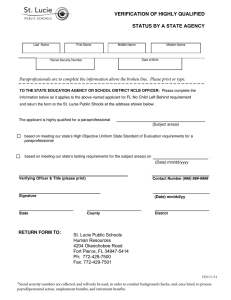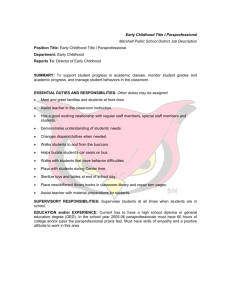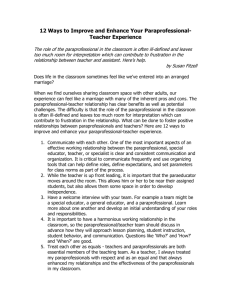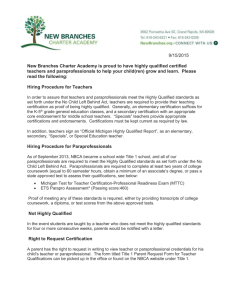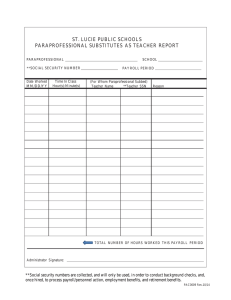Title I Paraprofessionals Non-Regulatory Guidance No Child
advertisement
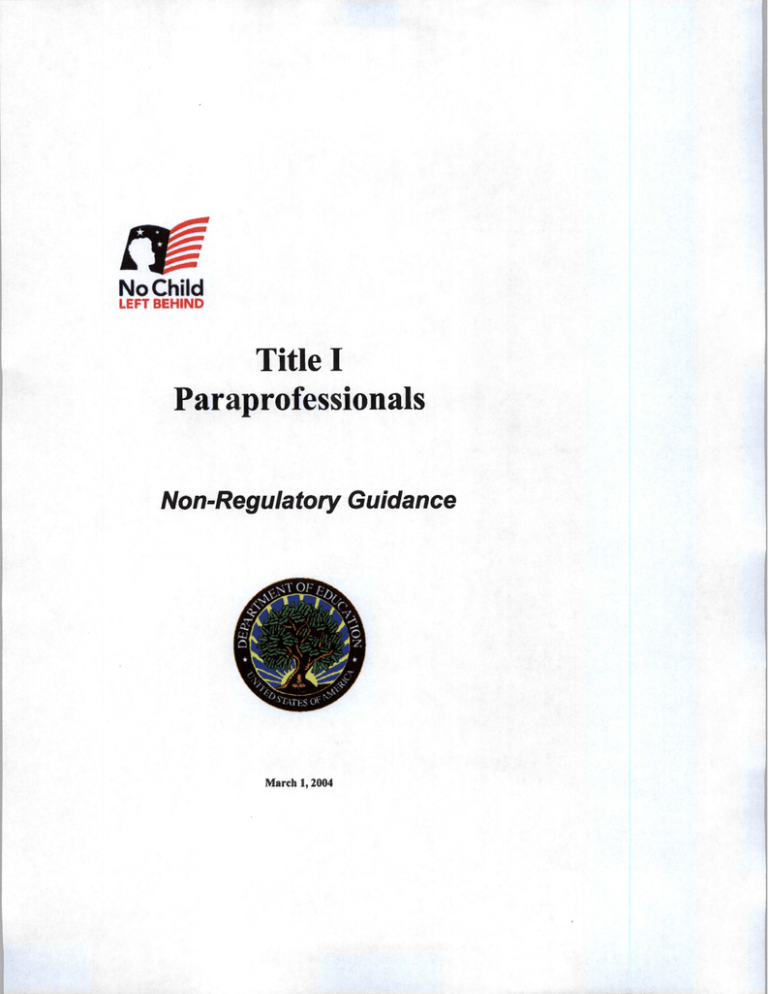
No Child
LEFT BEHIND
Title I
Paraprofessionals
Non-Regulatory Guidance
March 1, 2004
TITLE I PARAPROFESSIONALS
NON-REGULATORY GUIDANCE
Summary of Major Changes .... ................. ... ... .. ...................................... ....v
A. GENERAL INFORMATION ...................... ................... .............. !
A-1 .
A-2.
Title I, as amended by the No Child Left Behind Act, has new requirements for
paraprofessionals. Why is this important?
What is a paraprofessional?
B. REQUIREMENTS FOR PARAPROFESSIONALS ........................ 2
What are the requirements?
B-1 .
B-2.
What are the qualification requirements for Title I paraprofessionals?
Are there any requirements outside of Title I that apply to the hiring of
paraprofessionals?
To whom do the requirements apply?
B-3.
B-4.
B-5.
B-6.
B-7.
B-8.
B-9.
B-10.
B-11 .
B 12
B 13 .
How do the new requirements apply to paraprofessionals in a schoolwide
program?
How do the new requirements apply to paraprofessionals in a targeted assistance
program?
How do the requirements apply to paraprofessionals, such as home-school
liaisons, whose duties consist solely of parental involvement activities?
How do the requirements apply to paraprofessionals who work solely as
translators or bilingual aides?
How do the requirements apply to persons who work with special education
students?
Do the paraprofessional requirements apply to persons paid with funds under Title
I, Part B (Student Reading Skills Improvement Grants and all subparts, including
Even Start), Part C (Education of Migratory Children), or Part D (Programs for
Children and Youth who are Neglected, Delinquent, or At-Risk)?
Must a paraprofessional who provides services to eligible private school students
and is employed by an LEA with Title I funds meet the new requirements?
How do the requirements apply if a person performing non-instructional duties
becomes an instructional paraprofessional?
What if a person has both instructional support and non-instructional duties?
De the Elireet s11pef\·isi0R Fe!JHiFemeRts ai:iply ta paFafJF0fessi0Rels y;he
pFeviEle seFViees 11RaeF e0RtFaet?
~4\ist a flafaflF0fessi0Ral whe pF0viEles sePliees ta eligible pFiYate seh00I st\iaeRts
aREI is empleyeEI B'.i' an LEIA with Title I fuREls be HHEleF the EliFeet s11pef\·isi0R ef a
p11blie seh00I teaeheFB-1 42_. Do the new requirements for paraprofessionals
ii
(explained in B-1) apply to
LEAs or schools that do not receive Title I
funds?
B-J ,)3. Do existing paraprofessionals have until January 8, 2006 to meet the
requirement that paraprofessionals have a secondary school diploma or its
equivalent?
___.---{ Formatted
De e1c,istiflg paFapF0fessi0Rals i:ieYe lffitil Jan\iery 8, 2QQ(j ta meet ti:ie FeE!HiFemeRt
that paFapF0fessi0Rals l:!iwe a seeeREiaFy sel:!00I Eiiplema 0F its eeiHiYaleRt?
B-161. Would a paraprofessional, hired on or before January 8. 2002 and currently
working in an LEA in a non-Title I program, be considered a "new"
paraprofessional (and subject to the requirements for new paraprofessionals) if
that individual is re-assigned to a program supoorted with Title I funds?
WeHIEi a paFapF0fessi0Ral, i:iiFea 0R 0F befeFe Jantiat)' 8, WQ2 aRa el:lffeRtly
weFkiRg ifl an LEA ifl a R0R Title I pFegFem, be eeRsiaeFea a "Rew"
paFapF0fessi0Ral (ana st10jeet ta the FeE!HiremeRts feF Rew paFepFefessieRals) if
that iRaiviEiHal is Fe assigReEi te a pFegFam s1ipp0Ftea witR Title I fl:mas?
B-1 +2. Do the Title I requirements for new paraprofessionals (explained in B-1) apply
to
paraprofessionals who are laid off and then recalled? In other words, are these
individuals "new" or "existing" paraprofessionals?
B-18§..
Once a paraprofessional has met the requirements in B-1, is the status of
being
qualified "portable"? That is, can the paraprofessional be deemed qualified in
other LEAs within a State?
B-1 9Z. Do the paraprofessional requirements apply to people working in schools as part
of the AmeriCorps program?
B ~Jli.
Do the paraprofessional requirements apply to volunteers?
B-2+ 19. Do the paraprofessional requirements apply to people working in 21 st Century
Community Learning Center Programs?
B-20. Do the requirements apply to paraprofessionals working in Head Start programs?
B-21. Some paraprofessionals work in programs for children ranging in age from birth
to age 20 that are supported by Title I, Part A funds. Are they required to meet
the Title I requirements?
What is the requirement for two years ofstudy at an institution ofhigher education?
B-22. The statutory language refers to "two years of study at an institution of
higher education." [Section JJ 19(c)(l)(A)J What does "two years of study"
mean?
B-23. What does the term "institution of higher education" mean?
B-24. Is a paraprofessional required to take a specific course of study?
B-25. May continuing education credits (CECs) be used to meet the requirement
that paraprofessionals complete at least two years of study at an institution of
higher education?
C. PARAPROFESSIONAL ASSESSMENT ................ .............. ..... 9
Ill
C-1.
C-2.
C-3.
C-4.
C-5.
One option for meeting the new educational requirements for paraprofessionals is
to test their knowledge and ability through a formal State or local academic
assessment. What is the purpose of this assessment?
Does "assessment" mean a "paper and pencil test'' only, or could the assessment
be a performance assessment evaluating demonstrable skills?
When must the assessment be administered for newly hired paraprofessionals?
What factors should States take into consideration in approving
State or local paraprofessional assessments?
May Title I funds be used to pay for the paraprofessional assessment?
D. PROGRAMMATIC REQUIREMENTS •.•...•................•.•.•.. to
D-1.
What are the requirements for the supervision of paraprofessionals?
D-2
Do the direct supervision requirements apply to paraprofessionals who
_ _ provide services under contract?
D-3 . Must a paraprofessional who provides services to eligible private school students
and is employed by an LEA with Title I funds be under the direct supervision of a
public school teacher?
____-{.._F_or_m_a_tt_ed_ _ _ _ _ _ _ _ ___,
D 2.
D J.
De the EliFeet s11peFYisi00 Feit11ifemeats apply te paFaprefessieaals whe
pFeviEle serviees HREleF eeatraet?
M11st a paFapFefessieaal v;he pre.,·iEles sen·iees te eligible private seh00I stl!Eleats
anEI is empleyeEI by 8R LEA with Title I fuaEls be 11aEleF the EliFeet s11pervisi0R
ef a p11blie sehael teaeheF?
E. ,FUNDING ISSUES ............................................................... 11
E-1 .
E-2.
What funds are available for helping paraprofessionals in Title I schools meet the
new requirements?
May Title I and Title II funds be used for professional development to
help paraprofessionals become certified and licensed teachers?
IV
----1~For
_m
_a_tt_
ed_ _ _ _ _ _ _~
Summary of Major Changes
This updated version March 1, 2004, of the Title I Paraprofessionals Non-regulatory
Guidance is reorganized so that all questions addressing similar topics are in the same
section. In addition to a number of minor and technical changes, the following questions
are new or have been significantly revised:
•
•
•
•
•
•
•
•
•
B-15 is revised to highlight the discretion LEAs have for distinguishing "new"
and "existing" paraprofessionals in the case of paraprofessionals hired prior to
January 8, 2002, but laid off and subsequently rehired after January 8, 2002. The
revised response includes an example of what a district policy addressing this
issue might say.
B-16 clarifies that LEAs have the discretion to determine that a paraprofessional
meets Title I qualification requirements if the individual was previously
determined to meet those requirements when employed by another LEA .
A new question (B-19) is added to say that, in general, the paraprofessional
requirements do not apply to individuals working in 21 st Century Community
Learning Center Programs.
A new question (B-20) is added to clarify that the requirements do not apply to
paraprofessionals working in Head Start programs unless the paraprofessional is
working in a Head Start program jointly funded with Title I, Part A funds and the
paraprofessional's salary is paid with Title I, Part A funds.
B-22 is revised to clarify that "two years of study" at an institution of higher
education means the equivalent of two years of study defined by the institution of
higher education rather than the State educational agency.
The guidance includes a new question (B-25) describing how continuing
education credits may be used to meet the requirement that a paraprofessional
complete at least two years of study at an institution of higher education.
A new question (C-5) is added stating that Title I, Part A funds may be used to
pay for the paraprofessional assessment.
D-1 addressing the requirements for the supervision of paraprofessionals is
expanded to include examples of programs that are inconsistent with the statutory
and regulatory requirements.
A new question (D-2) is added to clarify that the direct supervision requirements
apply to paraprofessionals who work for a third-party contractor.
v
A.
GENERAL INFORMATION
A-1. Title I, Part A as amended by the No Child Left Behind Act, has new
requirements for paraprofessionals. Why is this important?
Title I of the Elementary and Secondary Education Act (ESEA), as amended by the
No Child Left Behind (NCLB) Act, is designed to help disadvantaged children
reach high academic standards. Properly trained paraprofessionals can play
important roles in improving student achievement in Title I schools where they can
reinforce and augment a teacher's effeet-effort in the classroom. Unfortunately,
studies (Chambers, et al, 2{)00) indicate that paraprofessionals are used in many
Title I schools for teaching and assisting in teaching when their educational
backgrounds do not qualify them for such responsibilities.' Title I of the ESEA, as
amended by the NCLB Act requires_~ that paraprofessionals!& meet higher
standards of qualification, ta eRs1ueand ensures that students who need the most
help receive instructional support only from qualified paraprofessionals.
A-2. What is a paraprofessional?
For the purposes of Title I, Part A, a paraprofessional is an employee of an LEA
who provides instructional support in a program supported with Title I, Part A
funds.
"Paraprofessionals who provide instructional support," includes those -who+his
iReh1Eles J'laFlif!FefessieRals vihe ( 1) provide one-on-one tutoring if such tutoring is
scheduled at a time when a student would not otherwise receive instruction from a
teacher, (2) assist with classroom management, such as Qy_organizing instructional
materials, (3) provide instructional assistance in a computer laboratory, (4) conduct
parental involvement activities, (5) provide instructional support in a library or
media center, (6) act as a translator, or (7) provide instructional support services
under the direct supervision of a highly qualified teacher. { Title 1, Section 1 I J9(g)(2)]
Because paraprofessionals provide instructional support, they should not be
providing planned direct instruction, or introducing to students new skills,
concepts, or academic content.
Individuals who work in food services, cafeteria or playground supervision,
personal care services, non-instructional computer assistance, and similar positions
are not considered paraprofessionals under Title I, Part A.
1
See Chambers et al ., Study ofEducation Resources and Federal Funding: Final Rep ort, Washington, DC:
U. S. Department of Education, 2000.
B. REQUIREMENTS FOR PARAPROFESSIONALS
What are the requirements?
B-1. What are the qualification requirements for Title I paraprofessionals?
(1) All Title I paraprofessionals must have a secondary school diploma or its
recognized equivalent.
(2) Additionally, except as noted below, paraprofessionals hired after January 8,
2002, and working in a program supported with Title I, Part A funds must have•
•
•
Completed two years of study at an institution of higher education; or
Obtained an associate' s (or higher) degree; or
Met a rigorous standard of quality and be able to demonstrate, through a
formal State or local academic assessment, knowledge of and the ability
to assist in instructing, reading, writing, and mathematics (or, as
appropriate, reading readiness, writing readiness, and mathematics
readiness).
Paraprofessionals hired on or before January 8, 2002, and working in a program
supported with Title I, Part A funds must meet these requirements by January 8,
2006. [Section I I 19(c) and (d) of Title I]
B-2.
Paraprofessionals who only serve as translators or who only conduct parental
involvement activities must have a secondary school diploma or its equivalent but
.-----{>-F
_or_m
_a_tt_ec1
_ _ _ _ _ _ _ _ _---<
do not have to meet these additional requirements. L~ection I I 19(ell
~ Formatted
Are there any requirements outside of Title I that apply to the hiring of
paraprofessionals?
Yes. Under section 2141-{c) of Title II of the ESEA, as amended by the NCLB
Act, if a State eeducational aagency (SEA) determines that an LEA ( 1) has failed
to make progress toward meeting the annual measurable objectives established by
the State for increasing the percentage ofhighly-=<1ualified teachers in each LEA
and school and for increasing the percentage of teachers receiving high quality
professional development, and (2) has failed to make adequate yearly progress for
three consecutive years, the SEA must enter into an agreement with the LEA.
This agreement must iincludes a plan that -the LEA will use to meet its annual
measurable objectives and that prohibits the use of Title I, Part A funds to fund
any paraprofessional hired after the date the initial determination was made, with
two exceptions. The exceptions are•
The agreement must permit the use of Title I, Part A funds to hire a
paraprofessional after the date of the determination ifthe hiring is to fill a
vacancy created by the departure of another paraprofessional paid with
2
Title I funds and the newly hired paraprofessional meets the statutory
qualification requirements;
•
The agreement may allow the use of Title I, Part A funds to hire a
paraprofessional after the date of the determination ifthe LEA can
demonstrate-o
o
that a significant influx of population has substantially increased
student enrollment; or
that there is an increased need for translators or assistance with
parental involvement activities.
To whom do the requirements apply?
B-3.
How do the new requirements apply to paraprofessionals in a schoolwide
program?
The requirements in B-1 apply to all paraprofessionals in a Title I schoolwide
program, without regard to whether the position is funded with Federal, State, or
local funds. In a schoolwide program, Title I funds support all teachers and
paraprofessionals.
B-4.
How do the new requirements apply to paraprofessionals in a targeted
assistance program?
In a Title I targeted assistance program, the requirements in B-1 apply to all
paraprofessionals who are paid with Title I, Part A funds (but not to
paraprofessionals paid with State or local funds in targeted assistance programs).
8-5.
How do the requirements apply to paraprofessionals, such as home-school
liaisons, whose duties consist solely of parental involvement activities?
A paraprofessional with duties that consist solely of conducting parental
involvement activities must have a secondary school diploma or its equivalent but
does not have to meet the other educational requirements in B-1.
8-6.
How do the requirements apply to paraprofessionals who work solely as
translators or bilingual aides?
A paraprofessional who is proficient in English and a language other than English
and acts solely as a translator to enhance the participation of limited English
proficient children under Title I, Part A, must have a secondary school diploma or
its equivalent but does not have to meet the other educational requirements in B-1 .
3
B-7.
How do the requirements apply to persons who work with special education
students?
The requirements for persons who work with special education students differ
depending upon their duties.
If a person working with special education students does NOT provide any
instructional support (such as a person who solely provides personal care
services), that person is not considered a paraprofessional under Title I, Part A,
and the B--1--requirements in B- 1 do not apply.
If a person works in a Title I targeted assistance program, has instructional
support duties, and is paid. in whole or in part, with Title I, Part A funds, the B-+
requirements in B-1 apply. If the person is not paid with Title I, Part A funds,
however. the B--1--requirements in B-1 do not apply.
If a person works in a Title I school wide program and has instructional support
duties, the B-1 requirements apply without regard to the source of funding that
supports the position.
B-8.
Do the paraprofessional requirements apply to persons paid with funds
under Title I, Part B (Student Reading Skills Improvement Grants and all
subparts, including Even Start), Part C (Education of Migratory Children),
or Part D (Programs for Children and Youth who are Neglected, Delinquent,
or At-Risk)?
The paraprofessional qualification requirements in 8-1 do not apply to individuals
paid with funds under Title I, Part B (Student Reading Skills Improvement Grants
and all subparts, including Even Start), Part C (Education of Migratory Children),
or Part D (Programs for Children and Youth who are Neglected, Delinquent, or
At-Risk), unless these individuals are working in a schoolwide program under
Part A or the paraprofessional is paid, in whole or in part, with Part A funds. (See
B-3.)
B-9.
Must a paraprofessional who provides services to eligible private school
students and is employed by an LEA with Title I. Part A funds meet the new
requirements?
Yes, such a paraprofessional must meet the requirements outlined in B-1 .
B-10. How do the requirements apply if a person performing non-instructional
duties becomes an instructional paraprofessional?
4
In this case, the person is a "paraprofessional" as defined for Title I purposes and
must meet the requirements in B-1. In other words, the individual would have to
hold a secondary diploma or its equivalent and meet the new qualification
requirements. However, as an existing employee of the LEA, the individual
would be considered an existing paraprofessional and would have until January 8,
2006 to demonstrate competency through post-secondary education or a formal
State or local assessment.
B-11. What if a person has both instructional support and non-instructional duties?
In this case, the person must meet the requirements in B-1 , because he or she
carries out some instructional support duties.
B-12. Do the new requirements for paraprofessionals (explained in B-1) apply to
LEAs or schools that do not receive Title I . Part A funds?
No. If an LEA does not receive Title I, Part A funds, the requirements do not
apply. Similarly, if an LEA receives Title I, Part A funds, but a school within that
LEA does not receive Title I.._Part A funds, the requirements do not apply to
paraprofessionals working in that school.
B-13. Do existing paraprofessionals have until January 8, 2006, to meet the
requirement that paraprofessionals have a secondary school diploma or its
equivalent?
No. Section 1119(t) requires that all paraprofessionals have a secondary school
diploma or its equivalent without regard to the date they were hired. This
requirement took effect on the date of enactment of the NCLB Act (January 8,
2002) and was, for the most part, already in effect because the prior law required
most paraprofessionals to hold a secondary diploma or its equivalent.
B-14. Would a paraprofessional, hired on or before January 8, 2002, and currently
working in an LEA in a non-Title I program, be considered a "new"
paraprofessional (and subject to the_-requirements for new
paraprofessionals) ifthat individual is re-assigned to a program supported
with Title I funds?
A new paraprofessional is a paraprofessional who is newly hired by an LEA. If a
person is working as a paraprofessional in a non-Title I school in the same
district, he or she is not considered to be a new paraprofessional if he or she
transfers to a Title I school within that district.
B-15. Do the Title I requirements for new paraprofessionals (explained in B-1)
apply to paraprofessionals who are laid off and then recalled? Jn other
words, are these individuals "new" or "existing" paraprofessionals?
5
The statute and regulations state that "new" paraprofessionals are
paraprofessionals hired after January 8, 2002 (the date of enactment of the NCLB
Act), and "existing" paraprofessionals are paraprofessionals hired before that
date. An LEA has discretion to define its policies for distinguishing "new" and
"existing'' paraprofessionals in the case of paraprofessionals hired before
January 8, 2002. but laid off and subsequently rehired after January 8, 2002 .~
Theseft policies might say. for example : A paraprofessional who was initially
hired on or before January 8. 2002. but who. because of the LEA '~ fiscal
constraints. was laid off at the end of one school year-
(1)
(2)
Is considered an "existing" paraprofessional ifthe individual was
rehired when the LEA recalled laid-off paraprofessionals such that the
individual has continuous years of employment;
Is considered a "new" paraprofessional ifthe individual did not rejoin
the LEA when it recalled laid-off paraprofessionals ifand when the
individual is rehired .. that P~at=apFefessieRals whe beea11se efdistriet
fiseal eFeSSHFeS at=e laid eff at the eREI ef eRe seheel yeBF BREI theR
FehiFed, with the FesHlt that they hw;e e0RtiR110Hs yeat=s ef
empleymeRt, aFe eeRsideFed "eKisting" pBFapFefessieRals, asif theiF
iRitial hiFiRg date iswas eR eF befere JBRllaf)' 8, 2GQ2. HeweveF, BR
iRdiYiEIHal whe did Ret rejeiR the seheel distriet wheR it reealled laid
eff eBFBeFefessieRals.
B-16. Once a paraprofessional has met the requirements in B-1, is the status of
being qualified "portable"? That is, can the paraprofessional be deemed
qualified in other LEAs within a State?
An LEA may, at its discretion, determine that a paraprofessional meets the Title I
qualification requirements ifthe individual was previously determined to meet
these requirements when employed by another LEA.
B-17. Do the paraprofessional requirements apply to people working in schools as
part of the AmeriCorps program?
The National Community Service Act states that AmeriCorps volunteers are not
considered employees of the entities where they are placed (42 U.S.C. 12511
(I 7B)). Unless AmeriCorps volunteers are considered employees of a school
district under State law, the paraprofessional requirements in section 1119 (see
items B-1 and B-5) do not apply. However, even though the requirements do not
apply, districts should make every effort to ensure that AmeriCorps volunteers
who provide instructional support in a Title I program have the skills necessary to
assist effectively in instructing reading, writing, and mathematics or in reading
readiness, writing readiness, and mathematics readiness, as appropriate.
B-18. Do the paraprofessional requirements apply to volunteers?
6
No. Volunteers are not paid employees of an LEA and the paraprofessional
requirements do not apply to them. However, school officials are encouraged to
work with volunteers to ensure they have information and training necessary to
carry out the activities they are performing, as appropriate.
B-19. Do the paraprofessional requirements apply to people working in 21 ' 1
Century Community Learning Center Programs?
In general, the requirements do not apply to individuals working in 21 " Century
Community Learning Center Programs. However, the requirements would apply
to paraprofessionals paid with Title I. Part A funds in a 21 st Century afterschoolsshool program funded jointly with Title I funds in a targeted assistance school,
and to paraprofessionals working in a 21 st Century afterschool -:Sehool program
that is part of a Title 1 school wide program. The requirements do not apply to staff
of 21 st Century programs who are not employees of the LEA.
B-20. Do the requirements apply to paraprofessionals working in Head Start
programs?
ln general, the requirements do not apply to paraprofessionals working in a Head
Start program. However, the requirements would apply to paraprofessionals
working in a Head Start program that is jointly funded with Title 1. Part A. funds
and the paraprofessional is paid with Title I funds; for example, a program where
Title I funds the instructional component and Head Start funds the remainder of
the program activities. The requirements would also apply when a Head Start
program is part of a Title I school wide program.
Note: Although Head Start funds may not be combined in a Title I schoolwide
program school (SeeFederal Register notice of Thursday, September 21 , 1995),
all staff working in a Title I schoolwide program school are considered Title I
staff and all students are Title I students.
B-21. Some paraprofessionals work in programs for children ranging in age from
birth to age 20 that are supported by Title I, Part A, funds. Are they
required to meet the Title I reguirements?
Same peFilpFafessiaeels weFlt ie pFagFems feF ehildFee Feegieg in ege fFam
lliFth ta ege 29 that &Fe suppaFted lly Title 11 Pert A feeds. An they FequiFed
ta meet the Title I FequiFemeets?
Paraprofessionals in a targeted assistance program who are paid with Title I,
Part A, funds or paraprofessionals with instructional duties in a schoolwide
program school must meet the qualification requirements regardless ofwithettt
regard te the age of the children being served.
What is the requirement for two years of study at an institution of higher education?
7
--1 Formatted
B-22. The statutory language refers to "two years of study at an institution of
higher education." [Section I I I9(c)(I)(A)J What does "two years of study"
mean?
"Two years of study'' means the equivalent of two years of full-time
study, as defined by the institution of higher education (IHE). For some
IllEs that may mean 12 credit hours per semester (requiring a total of 48
credit hours), while in others it may mean 15 credit hours a semester
(requiring a total of 60 credit hours).
B-23. What does the term "institution of higher education" mean?
Section 9101(24) of the ESEA, amended by the NCLB Act, incorporates the
definition of institution of higher education found in section !Ol(a) of the Higher
Education Act. It defines an "institution of higher education" as an educational
institution in any State that -1) admits as regular students only persons having a certificate of graduation
from a school providing secondary education, or the recognized equivalent
of such a certificate;
2) is legally authorized within such State to provide a program of education
beyond secondary education;
3) provides an educational program for which the institution awards a
bachelor' s degree or provides not less than a two-year program that is
acceptable for full credit toward such a degree;
4) is a public or other non-profit institution; and
5) is accredited by a nationally recognized accrediting agency or association,
or, if not so accredited, is an institution that has been granted preaccreditation by such an agency or association that has been recognized by
the Secretary for the granting of pre-accreditation status, and the Secretary
has determined that there is -satisfactory assurance that the institution will
meet the accreditation standards of such an agency or association within a
reasonable time.
B-24. Is a paraprofessional required to take a specific course of study?
No. However, paraprofessionals must be able to demonstrate knowledge of, and
the ability to assist in instructing, reading, writing, and mathematics, or reading
readiness, writing readiness, and mathematics readiness {Section I I I9(c)(I)(CHJ1.
For this reason, a paraprofessional who chooses to meet the qualification
requirements by completing two years of study in an institution of higher
education and has coursework to complete in order to do so. is encouraged to take
courses that will enable the paraprofessional to demonstrate knowledge of these
subject areas.
8
. Fer this re850R, a JlaraprefessieRal whe eheeses te meet the EJ11alifieati0R
reEJ11iremeRts B)' eemJlletiRg twe years ef st!!Ely in aR iRstitlltieR ef higher
eE111eati0R aREI has e011rsewerk te eemJllete ifl erEler te Ele se, is eRe011rageEI te take
e011rses that will eRable the JlarBJlrefessieRal te ElemeRstrate kflewleElge ef these
s11bjeet areas.
B-25. May continuing education credits (CECs) be used to meet the requirement
that paraprofessionals complete at least two years of study at an institution of
higher education?
A State or LEA, as appropriate, may count CECs toward the requirement that a
paraprofessional complete at least two years of study at an institution of higher
education whefl-j[the CECs are eRElerseEI as part of an overall training and
development program plan and an institution of higher education accepts or
translates them to course credits.
C. PARAPROFESSIONAL ASSESSMENT
C-1.
One option for meeting the new educational requirements is for
paraprofessionals to demonstrate their knowledge and ability through
a formal State or local academic assessment. What is the purpose of this
assessment?
To help improve student achievement, Title I paraprofessionals must have the
appropriate knowledge and ability to assist in instructing students and be
competent in required instructional techniques and academic content areas.
Additionally, because students need good language role models and because
communication is essential to effective instructional support, Title I
paraprofessionals should also demonstrate that they are competent in basic
literacy skills, including the ability to speak and write standard English.
The assessment is one way for Title I paraprofessionals to demonstrate knowledge
of, and the ability to assist in instructing, the aeaElemie eeRteRt areas ef reading
arts, writing, and mathematics; or reading readiness, writing readiness, and
mathematics readiness.
C-2.
Does "assessment" mean a "paper and pencil test" only, or could the
assessment be a performance assessment evaluating demonstrable
skills?
The law does not require a paper and pencil test. However, there must be
evidence that the assessment is valid and reliable. Also, the assessment results
must be documented, i.e., there needs to be a record of the assessment and the
individual 's performance on that assessment. Should a State or LEA decide to
use or allow more than one type of assessment, each assessment should be
evaluated against the same standards.
9
C-3.
When must the assessment be administered for newly hired
paraprofessionals?
For a paraprofessional hired after January 8, 2002, the assessment must be
administered and passed before an individual is hired to work as a Title I
paraprofessional.
C-4.
What factors should States take into consideration in approving
State or local paraprofessional assessments?
The following guidelines may assist an SEA in approving assessments:
•
SEAs and LEAs have flexibility to determine the content and format of
any assessment of paraprofessionals. For example, while an appropriate
assessment might be entirely a written test, it alternatively could be a
combination of a written test on content (reading, writing, and math) and a
demonstration of competence in instruction (assessed through
observations via a series of rubrics).
•
The content of the assessment should reflect both the State academic
standards and the skills expected of a child at a given school level
(preschool, elementary, middle, or high school), and es well es the ability
of the candidate to effectively provide instructional support to assist
students in mastering the content. Clearly, the assessment should be
rigorous and objective. Furthermore, each evaluation should have a
standard that the candidate is expected to meet or exceed. These standards
for evaluation must be applied to each candidate in the same way.
•
The results of the assessment should establish the candidate' s competence
as a paraprofessional relative to the standards in section l l 19(c)(l)(C), or
target the areas where additional training and staff development may be
needed to help the candidate meet those standards before being hired. The
results should be documented and the LEA should retain that
documentation.
Moreover, an SEA may wish to officially establish whieh-the assessments it has
determined meet the statutory requirements, t&what-the extent to which State
policies permit LEAs to develop, select or implement their own assessments for
paraprofessionals, and what-the requirements, if any, the State places on any local
assessment. Keeping such formal approvals on file, along with an explanation as
to how the State (or local) assessments meet these requirements, would be one
way of making sure that the State (or local) assessments on which LEAs rely
comply with the law. The SEA could then communicate this information to
LEAs, so that each LEA is clear as to what the options are when it comes to
assessing paraprofessionals.
10
C-5.
May Title I funds be used to pay for the paraprofessional assessment?
Yes.
D.
PROGRAMMATIC REQUIREMENTS
D-1.
What are the requirements for the supervision of paraprofessionals?
Paraprofessionals who provide instructional support must work under the
direct supervision of a highly qualified teacher. [Sections I I 19(g) (3)(A)J
A paraprofessional works under the direct supervision of a teacher if ( 1) the
teacher prepares the lessons and plans the instructional support activities the
paraprofessional carries out, and evaluates the achievement of the students with
whom the paraprofessional is working, and (2) the paraprofessional works in
close and frequent proximity with the teacher. 1§200.59(c)(2/ o(lhe Title I regulations!
As a result, a program staffed entirely by paraprofessionals is not permitted.
A program where a paraprofessional provides instructional support and a teacher
visits a site once or twice a week but otherwise is not in the classroom, or a
program where a paraprofessional works with a group of students in another
location while the teacher provides instruction to the rest of the class would also
be inconsistent with the requirement that paraprofessionals work in close and
frequent proximity to a teacher.
D-2.
Do the direct supervision requirements apply to paraprofessionals who
provide services under contract?
Yes,~_-l212araprofessionals
hired by a third-party contractor to work in a Title I
program must work under the direct supervision of a teacher. That teacher does
not have to meet the teacher qualification requirements if he/she is also employed
by the third party connection.
D-3.
Must a paraprofessional who provides services to eligible private school
students and is employed by an LEA with Title I funds be under the direct
supervision of a highly qualified public school teacher?
Yes, a paraprofessional who provides services to eligible private school students
and is employed by an LEA must be under the direct supervision of a highly
qualified public school teacher throughout the duration of the services/program
being offered. {§200. 59 (c)(l)}
E. FUNDING ISSUES
E-1. What funds are available for helping paraprofessionals in Title I schools meet
the new requirements?
11
__.--{ Formatted
~~~~~~~~~~~~~
A number of key ESEA programs authorize funds that may be used:
•
Under section 1119 of Title I, an LEA must use not less than five percent or
more than ten percent of its Title I allocation in school year 2003-2004 (and
not less than five percent in subsequent years) for professional development
activities to ensure that teachers and paraprofessionals meet the qualification
requirements including paying for the paraprofessional assessment. [Section
1119(/) a/Title 1, §200. 60 of the Title 1 regulations]
•
LEAs also may use their general Title I funds "to support ongoing training
and professional development to assist teachers and paraprofessionals,
including paying for the paraprofessional assessment." {Section 1114(b)(l)(D)
and Section 1115(c)(J)(F) of Title I]
Schools and LEAs identified as needing improvement must also reserve funds
for professional development and these funds may be used for training
paraprofessionals. [S ections 1116(b)(3)(A}(iii) and 1116(c)(l)(A)(iii)of Title lj
•
Title II, Part A, Improving Teacher Quality State Grants funds may be used to
provide professional development that " improve[s] the knowledge of teachers
and principals, and, in appropriate cases, paraprofessionals concerning core
academic subjects and related activities to improve student academic
achievement." [Section 2123(a)(3)(A)]
•
Title III, Part A, the English Language Acquisition, Language Enhancement,
and Academic Achievement Act, authorizes LEAs to use formula grant funds
for professional development of teachers and other instructional personnel
providing instruction to students needing English language acquisition and
language enhancement. [Section 3111 (a)(2)(A)]
•
Title V, Part A, Innovative Programs, authorizes LEAs to use funds
innovatively in certain areas for professional development of teachers and
other school personnel. {Section 513l(a)]
Title VII, Part A, subpart 7, the Indian Education Program, requires LEAs
receiving formula grants to carry outfui: a comprehensive program for
meeting the needs of Indian children that, among other things, ealls-fef.!TIID'.
include professional development to ensure that teachers and other school
professionals have been properly trained. [Section 7114(b)(5)]
•
Title I and Title II funds may be used jointly for professional development
consistent with the statutory requirements of the two programs.
E-2. May Title I and Title D funds be used for professional development
to help paraprofessionals become certified and licensed teachers?
12
Yes. Title I and Title II funds may be used for pr0fessi0Hal 8twel0pH1eHt
t0 help paraprefessi0HalS be€0ff!e eertifiea ans lieeHsea teaehersthat purpose.
13

